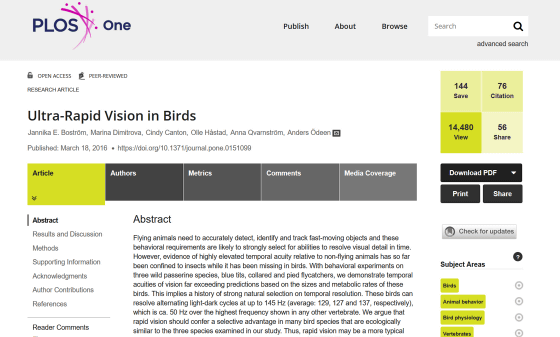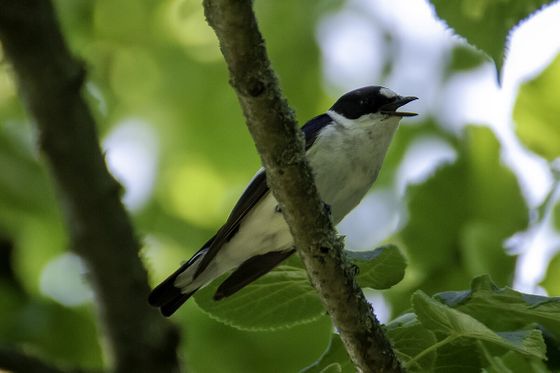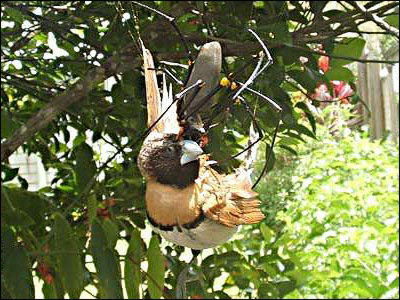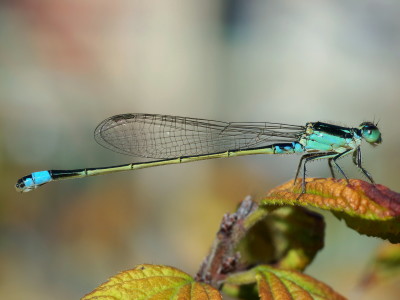Birds are more than twice as good as humans at recognizing ultra-fast flashing lights

by Wikimedia Commons
Birds flying in the sky need to quickly notice insects and obstacles moving at high speeds within their field of vision, identify their true identity, and track them. A paper published in 2016 by Swedish researchers reported that wild birds have visual temporal resolution (the ability to detect visual changes that occur within a certain period of time) that is more than twice that of humans.
Ultra-Rapid Vision in Birds | PLOS One

Small birds' vision: Not so sharp but superfast | EurekAlert!
https://www.eurekalert.org/news-releases/505824
Small Birds Have Ultra-Rapid Vision | IFLScience
https://www.iflscience.com/small-birds-have-ultra-rapid-vision-34628
The visual temporal resolution of animals is measured by the critical flicker frequency (CEF), which is the frequency (Hz) at which an animal perceives a rapidly flashing light as continuous or intermittent. The CEF for humans is said to be around 60 Hz, while flying animals such as birds and insects are thought to have a better CEF.
The research team captured wild individuals of three passerine species: the blue tit (Cyanistes caeruleus) , the collared flycatcher (Ficedula albicollis), and the spotted flycatcher (Ficedula hypoleuca) , and conducted behavioral experiments to measure CEF.
These small birds, about 10-14 cm in length, are thought to have a high CEF because they fly agilely through forests during the day. It has been shown that CEF correlates with metabolic rate and body size, and vertebrates with metabolic rates and sizes similar to these small passerines are estimated to have a CEF of around 100 Hz.

by Wikimedia Commons
The research team trained the captive birds to distinguish between flashing and steady lights while raising them. They trained them to prefer the steady light panel by placing food only in the hole under the steady light panel.
In the experiment, the birds were deprived of food for one hour before each session to motivate them to want food, and then they were shown a panel that flashed and lit continuously to see which one they would choose. Five sessions were conducted with the same flashing speed, and if the birds could choose the correct option four out of five times, they were considered to be able to distinguish between the flashing speeds.
The sessions began with a 50Hz flashing light, and as the birds successfully selected the correct panel, the flashing speed was gradually increased to 80Hz, 100Hz, and 120Hz. When it became difficult to select the correct panel, the flashing light was fine-tuned to determine the birds' CEF, and rigorous measurements were taken.
The results of the experiment confirmed that the CEF of the blue tit was up to 131 Hz, that of the collared flycatcher was up to 141 Hz, and that of the pied flycatcher was up to 146 Hz. These values are more than twice as high as those of humans and significantly exceed those estimated from metabolic rate and size.

by Wikimedia Commons
The fact that small passerines had significantly better CEF than predicted suggests that in these species, individuals with high CEF have survived as a result of natural selection .
Anders Odin , a co-author of the paper and an animal ecologist at Uppsala University, pointed out that a high CEF may be a typical trait for birds in general. 'There are many bird species that are ecologically and physiologically similar to blue tits, collared flycatchers, and pied flycatchers, and it's likely that these species share the ability of super-speed vision,' Odin said.
Related Posts:







